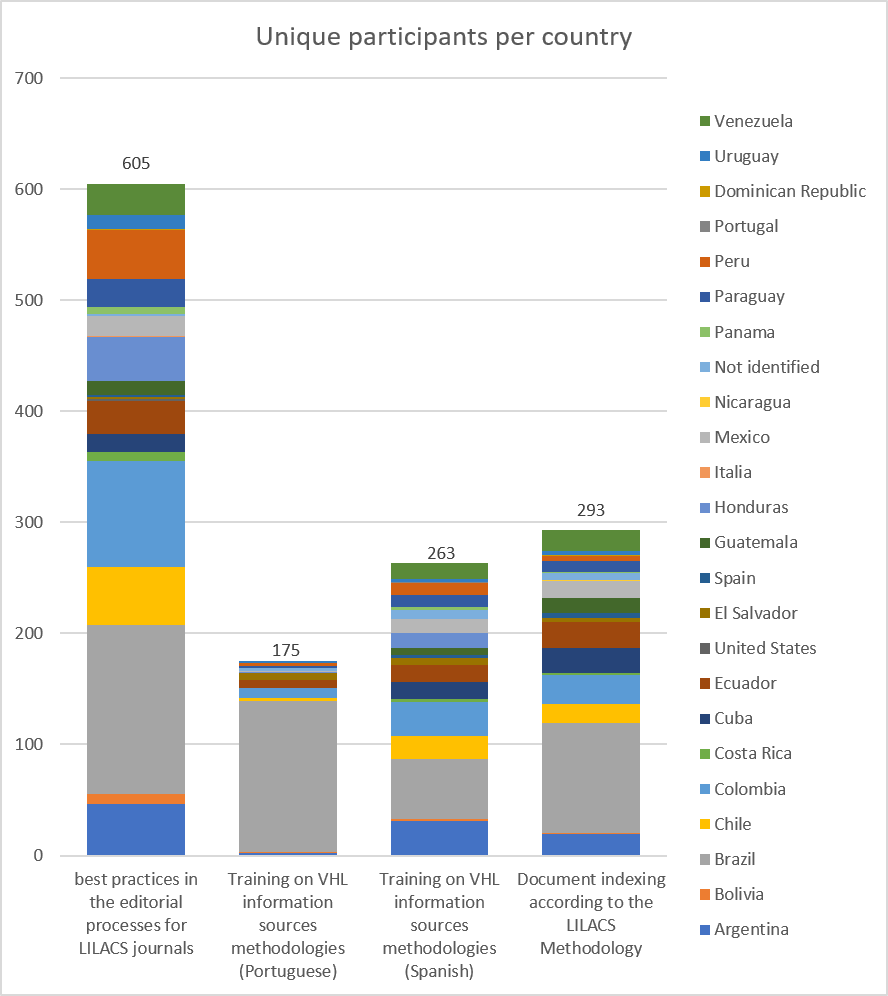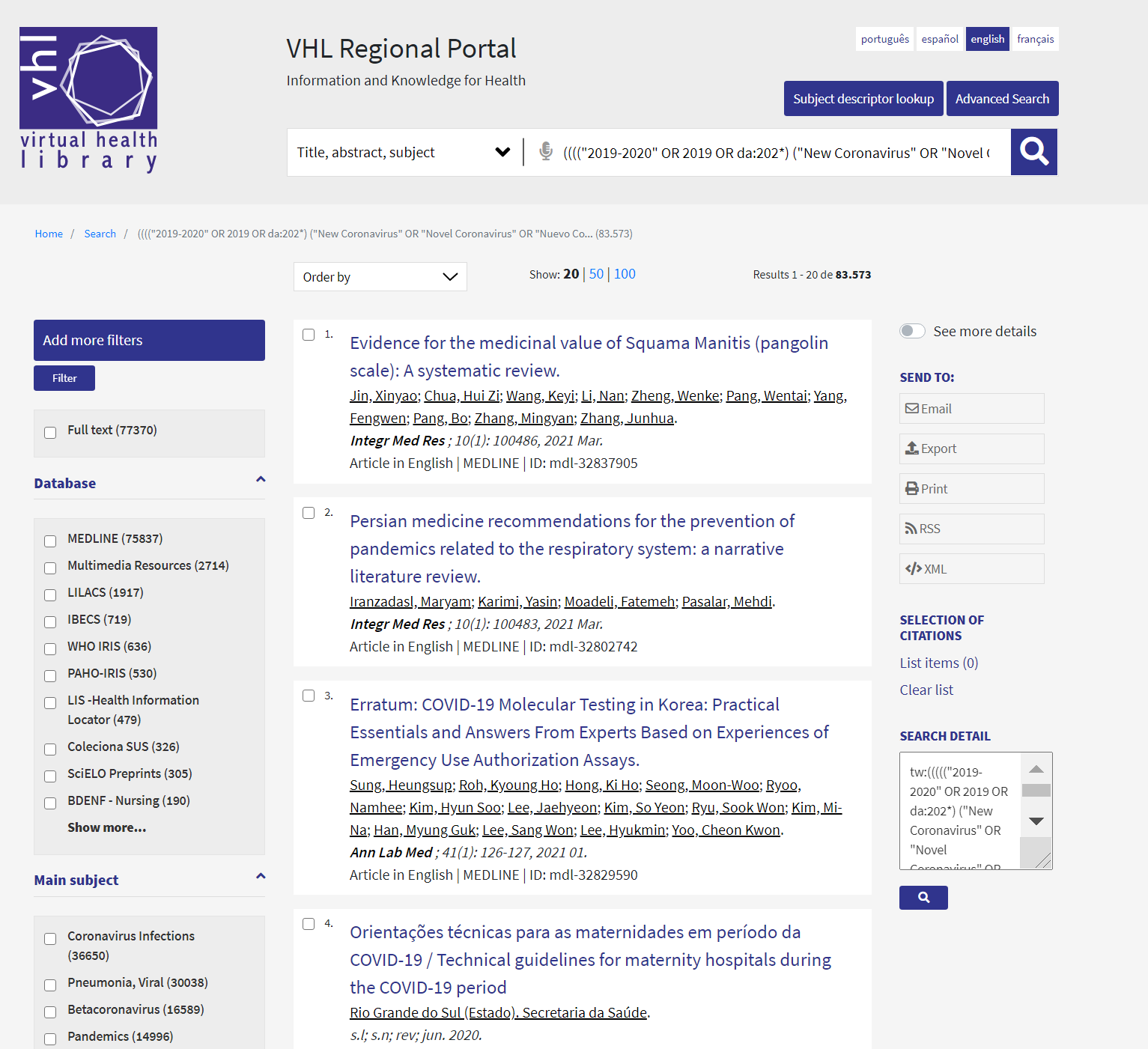From March to July 2020, besides the coordination meetings of the LILACS network[1], technical notes[2] and call to the network[3] for cooperation with publications on COVID-19, meetings and training took place in the virtual mode on the network: LILACS Coordination Meetings, best practices in the editorial processes for LILACS scientific journals, virtual document indexing sessions, according to LILACS Methodology, training on the VHL information sources for the Latin-American and Caribbean Health Sciences Information Network.

Twenty-three virtual sessions were held in editorial processes of LILACS journals (5); indexing documents according to the LILACS Methodology (5); and in the VHL information sources (7 for the Latin American network and 6 for the Brazilian network).
These trainings aim to maintain the updating of regional databases such as LILACS (scientific and technical literature), LIS (Internet resources), Events Directory and Multimedia Catalog; generate local capacity to develop and publish databases with national publications; and to offer good practices for the publication of scientific journals in the health area and guidance on the thematic indexing of these publications.
In addition to developing the management and feeding of information sources, the document indexing themes in COVID-19, social behaviors and psychological phenomena, neoplasms, the environment and experimental studies. In the sessions on editorial processes of scientific journals, the topics were the importance of indexing journals at LILACS, defining the scope of the journal, editorial flow, requirements for publication of electronic journals, open peer review and selection of content for scientific dissemination.
The training involved 1,348 connections in this period, reaching more than one thousand unique participants from 23 countries. (Figure 2)

In fact, there was a significant increase in the number of participants in training activities during COVID-19, compared to previous years.
| Training activity | 2020 (6 sessions) | 2019 (9 sessions) |
| Indexing of documents according to the LILACS Methodology | 293 unique participants | 274 unique participants (2017-2019)[4] |
| Editorial processes of LILACS journals | 605 unique participants | 516 unique participants[5] |
Besides the planning and dissemination of these trainings in advance through the national coordinators of LILACS and BIREME to the participants from previous years, it is believed that the increase also occurred due to confinement due to the pandemic and the rapid adaptation of the participants to access from their homes, in the teleworking regime.
Reflexes on COVID-19 cooperation with VHL information sources
The real impacts of the network’s coordination and formation actions will only be visible in the long term due to the need to apply good practices in scientific journals and the adoption of indexing rules, but the reflection in the contribution to sources of information on the subject COVID-19[6] can be viewed on the LILACS portal and the VHL Regional Portal, where 1901 scientific and technical documents are published on LILACS, 2708 multimedia resources, 479 Internet resources, 360 records in ColecionaSUS, 257 health technology assessment reports (BRISA) and others. (Figure 3)

In addition to this excerpt from COVID-19, there was contribution of other topics in regional information sources as seen in the table below:
| Regional databases | Registries | Countries | Cooperating Centers |
| LILACS[7] | 13,786 | 18 | 270 |
| LIS | 878 | 4 | 17 |
| Multimedia | 3,111 | 4 | 25 |
| Leyes | 605 | 1 | 4 |
| DirEve[8] | 481 | 3 | 18 |
Once again, the strength of the LILACS and VHL networks is demonstrated, which, facing and responding not only to the COVID-19 pandemic, continue to fulfill their mission of giving visibility to the scientific and technical output that responds to the needs for evidence to answer public health issues and research in Latin American and Caribbean countries.
[1]BIREME/PAHO/WHO. Reunión II – Como BIREME y la Red BVS está enfrentando a la COVID-19 en las Américas. In: Reuniones de Coordinación LILACS. 14 de abril de 2020. Available from: https://lilacs.bvsalud.org/es/reunion-de-coordinacion-de-la-red-lilacs-2020/
[2] BIREME/PAHO/WHO. Nota técnica 01/2020 – Indización de documentos sobre el COVID-19 y Coronavirus del Síndrome Respiratoria Aguda Grave 2 (SRAG-CoV-2) 07 feb. 2020 actual. 15 abr. 2020. Available from: http://docs.bvsalud.org/biblioref/2020/07/1103187/nota-tecnica-covid-19esrag-cov-2-20200415-1.pdf
BIREME/PAHO/WHO. Nota técnica 02/2020 – Orientaciones para hacer frente a la COVID 19 y teletrabajo en las redes LILACS y BVS. 27 mar. 2020. Available from: http://docs.bvsalud.org/biblioref/2020/04/1088093/nota-tecnica-orientaciones-teletrabajo-y-enfrentamiento-covid-_cStOgYu.pdf
[3] BIREME/PAHO/WHO. Acciones para el enfrentamiento de la COVID-19 en la BVS y LILACS y teletrabajo. [Mensaje enviado al grupo de coordinación LILACS y a coordinadores de BVS]. 31 mar. 2020. Available from: https://groups.google.com/g/coord-lilacs/c/gZkpNV6rQ1I/m/C2Vy49OuAgAJ
[4] BIREME/PAHO/WHO. Best Practices in the Editorial Processes for LILACS Journals. BIREME Bulletin. Available from: http://boletin.bireme.org/en/2020/02/29/best-practices-in-the-editorial-processes-for-lilacs-journals/
[5] BIREME/PAHO/WHO. Local capacities in 18 countries increase providing visibility to scientific output in health. BIREME Bulletin n° 32 Available from: http://boletin.bireme.org/en/2019/06/02/local-capacities-for-18-countries-increase-giving-visibility-to-scientific-production-in-health/
[6] BIREME/PAHO/WHO. Estrategia de búsqueda estandardizada sobre COVID-19 registrada en el Repositorio de estrategias de búsqueda en la BVS. 24 mar. 2020 actual. 10 jun. 2020. Disponível em: https://bvsalud.org/queries/search_strategy/coronavirus-covid-19/?l=es_ES&se=covid
[7] BIREME/OPS/OMS. Estadísticas de contribución a LILACS. In: Portal LILACS. Actualización 14/07/2020. Disponible en: https://lilacs.bvsalud.org/es/infometrias-lilacs/lilacs-estadisticas-de-contribucion/
[8] BIREME/OPS/OMS. Outras fontes de informação da BVS. In: Portal Red BVS. http://red.bvsalud.org/fi-admin-pt/outras-fontes-informacao-geridas-no-fi-admin/